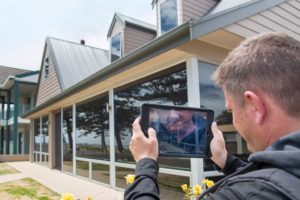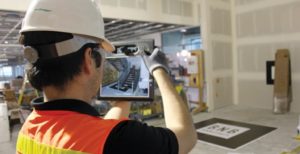
Pandemic provides opportunities to showcase best practices in digital services
Beginning in mid-March and continuing to the present day, the novel coronavirus (COVID-19) pandemic has caused unprecedented disruption to normal life across the United States. Over the course of just a few weeks, businesses, schools and houses of worship closed their doors and people sequestered themselves at home to minimize their exposure to the potentially deadly disease. For building safety professionals across the country, however, the pandemic has also presented a unique opportunity to test-drive innovative solutions for conducting remote plan review and inspections.
 Prior to the COVID-19 emergency, many jurisdictions across the country already had the ability to accept and review building plans electronically. Grand County, Utah, for example, switched to a web-based permit review system years ago — a process made easier by the fact that the two inspectors in this sparsely populated county might handle 100 to 200 permit requests a year — so closing the county’s building department to public access hasn’t been an issue.
Prior to the COVID-19 emergency, many jurisdictions across the country already had the ability to accept and review building plans electronically. Grand County, Utah, for example, switched to a web-based permit review system years ago — a process made easier by the fact that the two inspectors in this sparsely populated county might handle 100 to 200 permit requests a year — so closing the county’s building department to public access hasn’t been an issue.
“Our office is essentially ‘closed,’ but we are available for phone calls and emails,” said Grand County Building Inspector Cole Cloward. “We are able to meet if an appointment is set up, but we have been instructed to stay at least six feet away from others.”
Building officials in Alexandria, Va., began a trial run of an electronic permitting program late last fall; by the time the city closed its offices to the public in March, staff and customers alike were familiar with the new system. “The electronic system couldn’t have been ready at a better time, said Gregg Fields, CBO, CBMO, director of code administration for the city of Alexandria and a past president of the Virginia Building and Code Officials Association. “The larger contractors had been after us for a while to go electronic. They spend tens of thousands of dollars for these permits. And this is so much faster than paper.”
While many jurisdictions use special software designed specifically to manage the review and permitting workflow, some places are finding that good old-fashioned email works too. And not just for small jurisdictions either; the city of Santa Monica, Calif., has shifted its in-person process to email for receiving project plans for review, corresponding with applicants about questions, and sending scanned copies of permits to them when approved.
As a result, said Ara Sargsyan, building official for Santa Monica and president of the Code Council’s Los Angeles Basin Chapter, the city hasn’t had to turn down one permit or inspection request since mid-March, when California’s governor issued a shelter-in-place order that closed down city office buildings to the public.
Despite the growing trend toward all-electronic plan review, at the outset of the pandemic many jurisdictions around the country did not have such systems in place or were in the process of converting to them. In Arlington County, Va., for example, prior to the pandemic an average of 150 people a day visited the office to apply for permits while another 250 applied over the phone — only a handful submitted their plans electronically. Within a few days, the building department was able to switch the permit application process to an all-electronic format, allowing people to submit plans by email as PDFs.
“We went from an A-to-Z change in the way we operate in five days,” said Shahriar Amiri, the chief building official for Arlington County. “We just built on what we had.”
The pandemic forced the building department of Waltham, Mass., a city of 72,000 near Boston, to hurriedly switch its paper-based permit review process to one based on mail and email following the closure of government buildings to the public. “We still work with paper files,” said Waltham Inspector of Buildings/Superintendent of Public Buildings William Forte. “We’re in the process of finding a program, but we’re not there yet. Changing 100 years of procedures is a bit daunting.”
Although last year Waltham recorded $11 million in permit fees, its highest ever, for some $300 million in construction value, Forte said permit submissions and inspection requests have slowed dramatically since the state ordered most construction projects to shut down during the pandemic. Forte expects that business will rebound once the virus has run its course.
In neighboring Connecticut, however, construction has been designated an essential sector during the pandemic, even as building departments have been closed to the public. Mark McGovern, Director of Community Development for the city of West Hartford, said the volume of phone calls actually increased by about 50 percent between May and June, from about 2,000 calls to 3,000 calls.
Prior to the pandemic, the state government had wanted to automate the building permitting and inspection process; the original plan was to start with permit applications, but the more pressing need for virtual inspections bumped application automation to a subsequent step. However, when the transition is completed, it is expected to remain the standard for building departments across the state once the health emergency is over.
Virtual inspections set the standard for the future
 Permit inspections are one of the core activities of any building department; even in the middle of a global pandemic, as long as buildings are being constructed or renovated, and whenever a safety issue needs to be addressed, inspectors still have to see it for themselves. Thanks to modern technology, inspectors have many innovative options for doing just that — without putting their health or the health of their customers at risk.
Permit inspections are one of the core activities of any building department; even in the middle of a global pandemic, as long as buildings are being constructed or renovated, and whenever a safety issue needs to be addressed, inspectors still have to see it for themselves. Thanks to modern technology, inspectors have many innovative options for doing just that — without putting their health or the health of their customers at risk.
Remote inspections have been an increasingly common practice since the advent of smart mobile devices coupled with the widespread availability of streaming video services. Since March 23, the Arlington County building department has been able to conduct 3,000 inspections on buildings ranging from homes to high-rises with below-grade levels. The county provides a detailed process on its website of how to apply for, prepare for, and conduct virtual building, electrical, mechanical, plumbing, energy and certificate-of-occupancy inspections. Inspectors determine whether a project is too complex for a virtual inspection; if it is, the county accepts third-party inspections. Customers must have a smartphone or tablet connected to Wi-Fi or 4G wireless service and be able to host the video call using Google Duo, FaceTime or Microsoft Teams.
Amiri believes the trend toward remote inspections could be a boon for hiring. “We have such a difficult time finding qualified people in our business these days,” Amiri said. “But why couldn’t a person work remotely in other cases?”
The city of North Las Vegas, Nev., was an early adopter of real-time video inspections on qualifying projects, which has allowed its eight inspectors to continue performing many inspections from home during the pandemic. “We are using 100-percent video inspections now, said Valarie Evans, building official for North Las Vegas. “We started the program in July 2019, and I had planned to go 100 percent with video by July 2020. So, we were in pretty good shape to start now.”
As with Arlington County, the process starts with an application on the city’s website, using the Appointment Plus software package. Evans includes everyone on the list who will need to be involved, including the homeowner and each inspector who will have to sign off on the inspection. Customers and contractors must have at least 4G wireless service and fully charged mobile devices. The contractor doing the work can use a video system of their choice — Skype, Zoom or even just a smartphone, tablet or laptop camera — to walk the inspectors through the project. The contractor points the camera as directed by the inspector and answers questions as they move through the job site.
“At first, we had to tell them to slow down so we could see what we needed to, maybe even back up to make sure,” Evans said. “But now, most contractors know what we want to see and slow down to make sure we can see it.”
While personal inspections are on hold until the state’s stay-at-home orders have been lifted, the town’s inspectors have been able to complete around 600 inspections using the video system, with only a handful needing to be put on hold. The list of projects that are eligible for remote inspection include rooftop solar construction, aluminum patio covers, water heaters, water softeners, plumbing re-pipe, gas line extensions for barbecues and fire pits, air conditioner change-outs, attic forced air units, mainline water repairs, electrical service changes, spa circuits, and detached storage sheds that do not exceed 600 square feet.
In Santa Monica, 80 percent of its building inspections are now being done remotely using various social media platforms. Sargsyan, said he modeled his town’s program on the virtual inspection program in neighboring Anaheim. “Luckily, we already are set up for electronic permitting, so we just started the video program earlier,” Sargsyan said. “The city of Los Angeles just began a video inspection program as a pilot program last year. Others have seen the video inspection protocols we posted and asked if they could use them. We said, ‘Sure, that’s what this is for. Just change the logo for your town.'”

Miami County, Ohio, already had a remote inspection program fully in place prior to the pandemic, the result of a plan adopted by chief building official Rob England to make it easier for his building inspectors to cover five western Ohio counties spread over 2,200 square miles. “I was just trying to figure out how to cover building inspections for such a massive area with a skeleton crew,” said England. “If a builder needs an emergency inspection, it can take an hour and a half, one way, to get there.”
England’s plan allows contractors to use iPads and iPhones for remote inspections for items such as concrete slabs, light pole bases, foundation walls, insulation, ice guards, re-inspections for specific items and above-ceiling inspections. “We will be able to do 75 percent of inspections using our Virtual Inspection Program,” England said. “All we needed to do was buy a few iPads and iPhones.”
England said his inspectors still have a supply of gloves and sanitizers and follow all protocols established by the Centers for Disease Control and Prevention, just as they had done during the H1N1 outbreak in 2009.
Construction officials in Belleville Township, N.J., use Zoom — the free, popular video conferencing software which has become a staple of group meetings during the pandemic — to safely conduct virtual home inspections. By late April, township officials had already conducted 12 home inspections using the remote technology.
“We found that it really works well because not only can we see the home clearly, but we can communicate with the agent,” said Township Construction Official Frank DeLorenzo. “We can tell him or her to move in a certain direction or to zoom in closer if there’s something that requires a closer look. We’ll have the agent get close to the boiler so we can inspect that, for example. We’ll have the agent test the smoke detectors. We will walk the agent through every step of the inspection process.”
Mayor Michael Melham said he is pleased with the success of his township’s virtual residential inspection program. “Home sales can continue in Belleville and we don’t have to sacrifice safety — either by possibly exposing township workers to COVID-19 or by conducting substandard inspections,” Melham said.
Due to technological or logistical limitations, however, many jurisdictions around the country are still doing in-person building inspections — though they are taking also measures to protect the health of inspectors, contractors, and owners who are on-site during those inspections. In Millburn Township, N.J., for example, the building department’s inspectors still conduct in-person inspections though they require everyone on-site to be wearing masks and gloves and stay at least six feet away.
Jerry Eger, Millburn Township’s construction code official, said he doesn’t like virtual inspections. “I like to look things over in person and tell the contractor what’s wrong and what he needs to fix,” said Eger, who is also president of the New Jersey Building Officials Association and chairman of the Municipal Construction Officials Association of New Jersey. “Some contractors we’ve been working with a long time, you can trust them. Some others, you have to keep your eye on.” Millburn does allow paperless permit applications, however.
 In Waltham, Mass., inspectors are limiting in-person inspections to just those projects that the state’s governor has deemed essential, such as properties subject to real estate closing or substantially renovated one- and two-family unoccupied buildings. Forte said that only the inspector is allowed on-site during an inspection. “Non-essential inspections can either be done by pictures and email, or if too complex, must be on hold until we can substantiate compliance,” Forte said.
In Waltham, Mass., inspectors are limiting in-person inspections to just those projects that the state’s governor has deemed essential, such as properties subject to real estate closing or substantially renovated one- and two-family unoccupied buildings. Forte said that only the inspector is allowed on-site during an inspection. “Non-essential inspections can either be done by pictures and email, or if too complex, must be on hold until we can substantiate compliance,” Forte said.
Lack of high-speed internet access, especially in rural parts of the country, can be a hindrance to implementing a virtual inspection program. For example, Wi-Fi connectivity in and around Grand County, Utah, is pretty iffy, Cloward said. “You can drive along some spots of the Colorado River for 20 minutes and not get a signal.” That’s why the county’s building department still does most of its inspections in person while requiring appropriate social distancing. Connectivity issues like that are probably not going to be solved before the pandemic is over but building officials can certainly use their experiences from this pandemic to make a strong case for investment in greater broadband coverage in the future — before the next pandemic strikes.
These are just some of the ways that building safety officials have addressed the challenges facing them and their departments during the unprecedented restrictions imposed by the COVID-19 pandemic. The situation has provided a unique opportunity for the industry as a whole to jumpstart its thinking about the ways that mobile technology can be applied to solve long-term challenges such as recruitment and retention of tech-savvy career professionals.
Remote inspections are beneficial beyond pandemics. A robust virtual system could allow a jurisdiction to bounce back quickly after a natural disaster such as a fire or hurricane, when power is sometimes not available for days and roads are impassable — and inspections are critical for ensuring the safety of lives and property. And in departments with fewer people, virtual inspections can materially increase the amount of work that a single inspector can perform, especially when inspectors have to cover large metropolitan or rural areas.
Regardless of the systems and approaches used to continue accepting and reviewing permits and conducting building inspections, jurisdictions should see the COVID-19 pandemic as an opportunity to start thinking systematically about developing and implementing training models for virtual inspections so that they are prepared for the next emergency.







